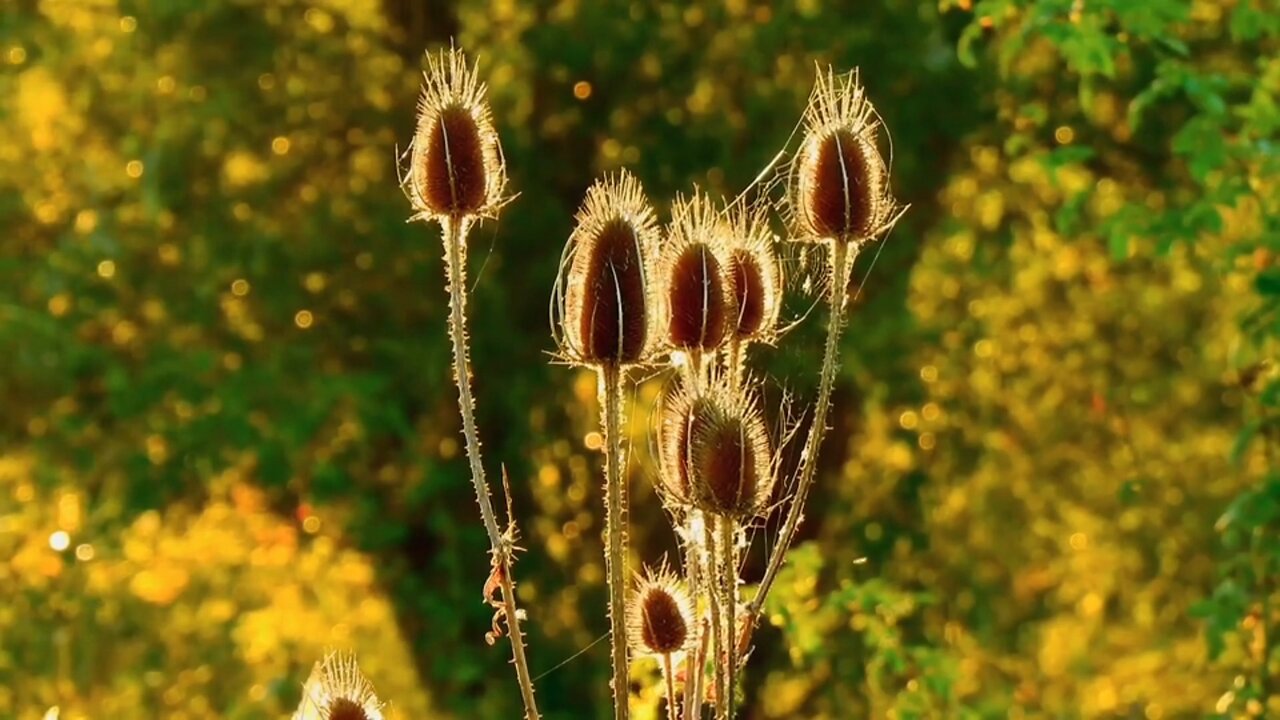Premium Only Content

"Teasel: A Spiny Tale of Nature's Adaptation and Resilience"
### Teasel (*Dipsacus* spp.)
**General Description:**
Teasel is a tall, herbaceous biennial plant belonging to the *Dipsacaceae* family. The plant is easily recognized by its spiny stems and large, spiky, cone-shaped flower heads. The flowers are typically purple, lavender, or white, and bloom in rings around the flower head, starting from the middle and progressing towards the top and bottom.
**Growth Habit:**
- **Height:** Teasel can grow between 1.5 to 2.5 meters (5 to 8 feet) tall.
- **Leaves:** The leaves are lance-shaped, with toothed margins, and are arranged in opposite pairs along the stem. In some species, the leaves are fused at the base, forming a cup that can collect rainwater.
- **Stem:** The stems are ridged and covered in sharp, prickly spines.
**Flowering and Reproduction:**
- **Flower Heads:** The distinctive flower heads are composed of numerous small flowers that bloom sequentially in bands. The flowering typically occurs from mid-summer to early autumn.
- **Pollination:** Teasels are primarily pollinated by bees, butterflies, and other insects. The flowers are rich in nectar, attracting a variety of pollinators.
- **Seeds:** After flowering, teasels produce large quantities of seeds, which are dispersed by wind and animals. The seeds are a valuable food source for birds, particularly finches.
**Ecological Role:**
- **Wildlife Habitat:** The spiny structure of the teasel's flower heads provides excellent protection for small insects, and the plant is often used by spiders as a framework for building webs, as seen in the image.
- **Food Source:** Birds, especially goldfinches, feed on the seeds during the winter months when other food sources are scarce.
**Habitat and Distribution:**
Teasels are native to Europe, Asia, and North Africa but have been widely naturalized in other parts of the world, including North America. They thrive in disturbed soils, along roadsides, in meadows, and in other open, sunny areas. The plant prefers well-drained soils but can adapt to a variety of soil conditions.
**Human Uses:**
- **Textile Industry:** Historically, dried teasel heads were used in the textile industry to raise the nap on fabrics like wool, a process known as "teaseling."
- **Ornamental Use:** Due to their unique appearance, teasels are often used in dried flower arrangements and as ornamental plants in gardens.
- **Traditional Medicine:** Some species of teasel have been used in traditional medicine for their purported anti-inflammatory and pain-relieving properties, although scientific evidence supporting these uses is limited.
**Invasive Potential:**
In some regions, particularly in North America, teasel has become an invasive species, spreading aggressively and outcompeting native plants. It is often found in large, dense stands that can dominate the landscape and reduce biodiversity.
**Management:**
Controlling teasel can be challenging due to its prolific seed production. Management strategies include mowing before the plant sets seed, removing flower heads to prevent seed dispersal, and applying herbicides in areas where teasel is particularly invasive.
### Conclusion:
Teasel is a fascinating plant with a rich history and significant ecological impact. Its striking appearance and adaptability make it a prominent feature in many landscapes, but its invasive potential also requires careful management in certain regions.
-
 4:31
4:31
CoachTY
21 hours ago $21.53 earnedCOINBASE AND DESCI !!!!
113K9 -
 10:02
10:02
MichaelBisping
20 hours agoBISPING: "Was FURY ROBBED?!" | Oleksandr Usyk vs Tyson Fury 2 INSTANT REACTION
57K13 -
 8:08
8:08
Guns & Gadgets 2nd Amendment News
2 days ago16 States Join Forces To Sue Firearm Manufacturers Out of Business - 1st Target = GLOCK
91K86 -
 10:17
10:17
Dermatologist Dr. Dustin Portela
2 days ago $17.45 earnedOlay Cleansing Melts: Dermatologist's Honest Review
132K11 -
 1:02:20
1:02:20
Trumpet Daily
2 days ago $41.37 earnedObama’s Fake World Comes Crashing Down - Trumpet Daily | Dec. 20, 2024
89.9K58 -
 6:29
6:29
BIG NEM
1 day agoCultivating God Mode: Ancient Taoist NoFap Practices
66.6K17 -
 30:53
30:53
Uncommon Sense In Current Times
2 days ago $10.87 earned"Pardon or Peril? How Biden’s Clemency Actions Could Backfire"
80.7K5 -
 40:01
40:01
CarlCrusher
1 day agoSkinwalker Encounters in the Haunted Canyons of Magic Mesa - ep 4
74.7K9 -
 59:44
59:44
PMG
2 days ago $10.04 earned"BETRAYAL - Johnson's New Spending Bill EXPANDS COVID Plandemic Powers"
76.3K49 -
 6:48:50
6:48:50
Akademiks
1 day agoKendrick Lamar and SZA disses Drake and BIG AK? HOLD UP! Diddy, Durk, JayZ update. Travis Hunter RUN
195K34